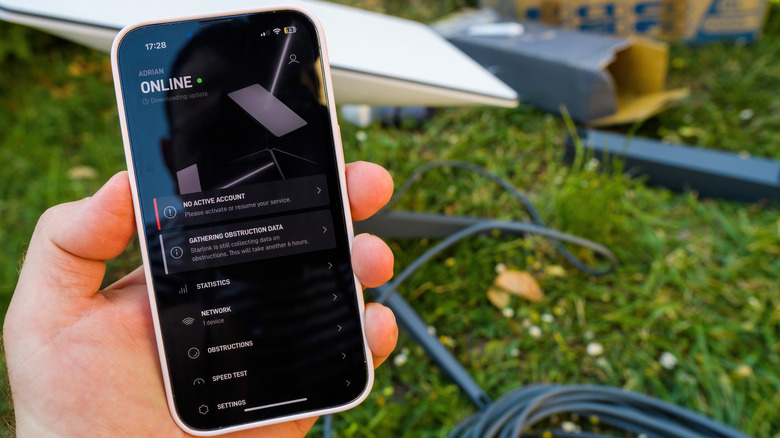What Is Starlink Mesh And How Does It Compare To Other Mesh Networks?
We may receive a commission on purchases made from links.
If you've looked into satellite internet, you'll have seen Starlink pop up often. A subsidiary of SpaceX, Starlink uses an array of satellites orbiting the Earth to provide internet connections to those who can't get cable or fiber internet. Starlink is a great service that helps those in rural or isolated areas get connected. While the price can be steep, it's worth it for many who need to rely on satellite internet.
Over the years, the company has grown to include more and more services. One of these special services is Starlink mesh, a system of mesh Wi-Fi routers that helps ensure you can access the internet anywhere in your home. Mesh networks are great for larger homes, as they help extend your Wi-Fi signal with minimal data loss. But this technology is nothing new, which begs the question — what sets Starlink mesh apart from other mesh networks? The truth is, not much.
How does Starlink mesh work?
Starlink mesh works by starting with a centralized Starlink router and placing up to three mesh routers in parts of your house that have a diminished connection. The mesh routers will act like signal repeaters, but unlike a typical Wi-Fi extender, there will be far less of a speed loss. This makes it so you'll be able to get nearly the same Wi-Fi speeds anywhere in your home.
But what makes Starlink mesh really stand out is just how easy it is to set up. By using the Starlink app, you can use the Wi-Fi Scanner to find weak signals and easily pinpoint the best locations for the mesh routers. Setting up the mesh routers is nearly seamless as well, and the app will always have a wealth of information about the network's performance and any issues that might come up.
Arguably the biggest advantage, however, is that if your main Starlink router breaks, you can use one of the mesh router nodes as your main router instead, provided the broken router was a Gen 2 or Gen 3 router. This can save you a lot of money if your router breaks down. However, this feature (and Starlink mesh in general) is not compatible with Gen 1 Starlink routers, so this is something to keep in mind when considering Starlink mesh.
How does Starlink mesh differ from other mesh networks?
The idea and inner workings of Starlink mesh are no different from a normal mesh network. Both require a router in a central location and use mesh routers to extend the signal around the house. The only real difference with the technology is that many people are on cable internet networks and Starlink is a satellite internet network, which can lead to different connection speeds and stability. This is more of a difference between the general connection types, though, not with Starlink mesh.
But even with the inner workings being the same, there are two other caveats to using Starlink mesh. Starlink warns that using more than three mesh routers may cause performance issues and that routers shouldn't be placed more than two rooms apart. Most mesh networks don't state this limitation, though too many mesh routers will impact performance, especially if they're too close together — although, for the most part, other mesh networks can handle more than three of them.
The second is that if you decide to use Starlink mesh routers, you can't also use third-party mesh routers to expand your network, as the Starlink mesh routers will be incompatible. While this is technically possible with other router brands, it is typically not recommended due to compatibility and connectivity issues. Some manufacturers, like TP-Link, mention their mesh routers are compatible with mesh routers of the same product line, but mixing and matching mesh routers from different brands is not recommended.
Can I use other mesh networks with my Starlink router?
There's no denying that Starlink mesh routers are expensive, with them costing $130 a piece (and are hard to find for sale outside Starlink's account-locked store). For comparison, the TP-Link Deco 3-pack costs only $190, making the price between the two networks staggering. If Starlink's mesh is too expensive, you can still create a mesh network using third-party mesh routers. This will be a bit harder to set up than a Starlink mesh network, but for some, the extra setup will be worth bypassing the limitations and saving money.
To use a third-party mesh router, you need to first plug the mesh node into the Starlink router so the app can register it, and after, you can enter bypass mode. Bypass mode allows you to use third-party routers, but it also disables the router features within the app, meaning you'll lose the convenience of having all of that helpful state you'd get.. You may even need to create a static route on your router for the mesh routers to work. Given the hoops to jump through, it's worth taking the time to determine if it's better to pay the premium for Starlink mesh, or if a third-party network is the best option.



